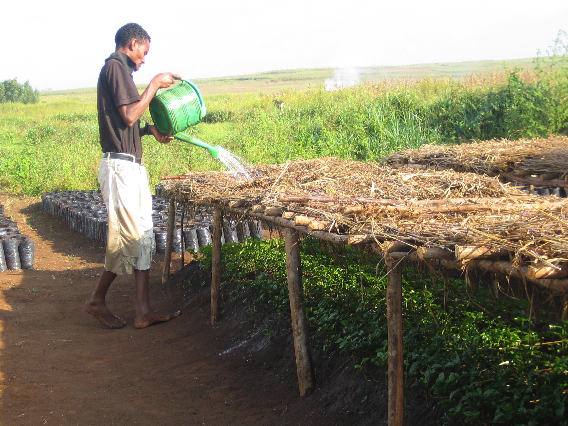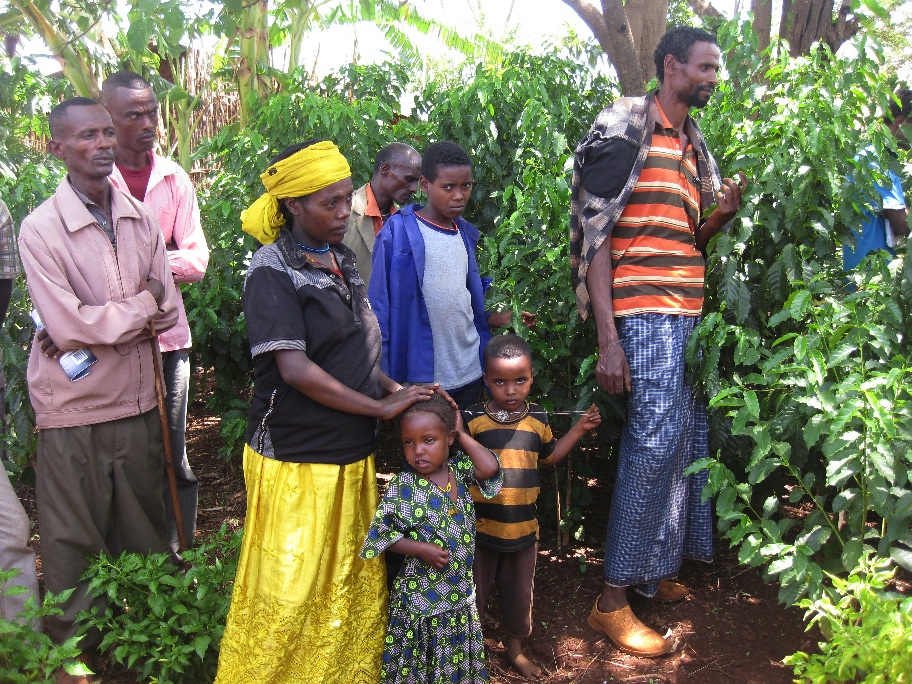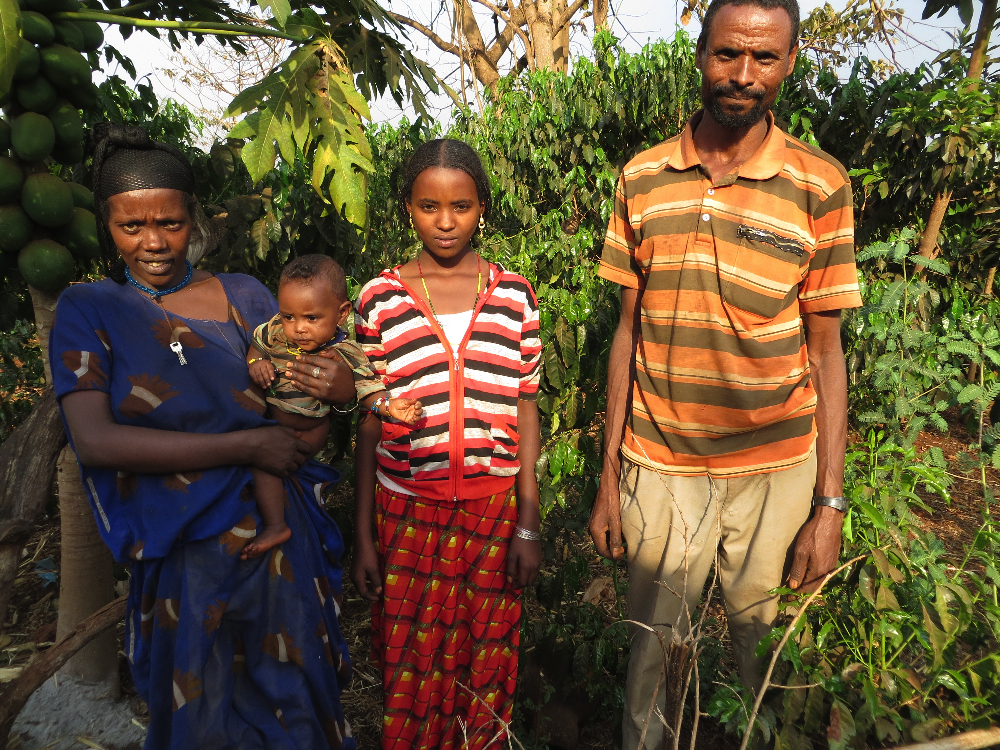
Food for the Hungry (FH) is a Christian organization serving the poor globally since 1971. They reflect the love of Christ in short-term emergency relief and long-term work to end world hunger. Learn about FH's vision, mission and values.
We were impressed with the mission statement of Food for the Hungry so we asked to interview the man in the field, Feye Tolla, to see how our small donation of coffee plants would be used. To say that we were impressed was an understatement.
Q. How did you get involved?
A. I was a former College Teacher when the opportunity to take a job as a trainer for Food for the Hungry came up in 1998. Since then I have had several assigments and now I am the Community Training Sponsorship Advisor. I took the job because I was looking to help people who are struggling to get out of poverty.
Q. Can you provide us with some background for our readers?
A. The work in Sasiga focuses on improving the standard of living for all members of their villages. It's takes a wide variety of projects done with (not for) the families and leaders there. From the various projects implemented in the community, we are especially excited about their ability to increase agricultural production & productivity, environmental protection and livestock production. In the production of cash crops and income generation, the project is working effectively with government research centers to introduce improved seed varieties that cope better in the existing climate - such as coffee plants. Before now, the farmers there did not think coffee plants would grow there; but starting up coffee bean production in their communities is like a dream come true.
Q. How did you get involved with Managing a Coffee Plantation?
A. I am not an expert in agriculture. I am a professional manager who works with experts that have been identified to help us overcome any challenges that have come up. My job is to identify the challenges in getting a project like this started, managing the startup stages, getting the project running and then handing the project back to the community when it is self sufficient.
Q. How does that methodology apply to the project?
A. We first had to study the locality and suitability of various crops. It was determined the coffee was a suitable crop for this area. As a cash crop coffee was very exciting to us. We tested growing here and when we had some success we proposed to the local community that we help them establish local coffee farms on many of the small plots of land in the area to improve the community and create a self sufficient economy.

Q. What long terms goals did you include in your proposal?
A. Our Goal was to establish a permanent crop for the sustained improvement of the community and to get as many of the local families involved as possible. There is a saying " If you give a man a fish he eats for a day. If you teach a man to fish he eats for life." Our goal is always to help communities help themselves by providing the initial helping hand in terms of start up resources and expertise.
Q. How is the project progressing?
A, We are progressing very well. It takes 2 years to establish a plant and 4-5 years for a tree to start producing fruit. So it is a long term project. The biggest challenge was convincing people to invest in the long term back when we started this project in 2006. It will take 4 more years for the community to become self sufficient to the point where the community will have learned how to cultivate seedlings on their own. At that time we won't be needed any longer.
Q. What can you tell us about the community?
A. The plantation is in the local Community of Sasiga Ethiopia. It is a very rural community of about 36,000 people or about 7,000 families. Before 2006 the majority were living below the poverty line of less than $1.25 per day. Most of the families live in simple huts and there aren't really any significant towns. Only a small percentage of the community were able to go to school and hunger was common place. Since 2006 approximately 40% of the families were able to participate in the program. There are coffee trees everywhere. We estimate that there are about 100,000 coffee trees under cultivation. Since coffee is a cash crop and a very important export for Ethiopia even those families not growing coffee are benefitng by the influx of jobs and cash into the local economy.
Q. Speaking of the government, have they been helpful?
A. Oh Yes, The local and National government are very well organized. They have provided support in terms of technical experts, research to improve seeds access to markets for our crops. Their approach has been very collaborative with the goal of making this a self sufficient community.
Q. What have been some of the other effects?
A. Now that the economy is growing there is more access to things like running water, electricity and roads. There are even cell towers and internet access. We are creating our own market economy for things like clothes shoes and consumable products.
Q. Can you tell about any specific family success stories?
A. Aliyi Jibiro is one of the farmers living in the project operational area since 2003. It was very bare land back then, void of vegetation. Termites posed another major threat that farmers had to deal with back then as they would consume anything green. As a result of the capacity building & provision of inputs carried out by the project to targeted farmers, Aliyi was one of the farmers who benefited and worked hard to get rid of the termites from his farm which he succeeded to do. The project trained the farmer and provided him with the seedlings of coffee to let him plant and manage on his own plot of land, which he has since 2008. Starting from 2012, he started to drink coffee from his farmland and as of 2013, he sold this commodity and earned 500 Ethiopian birr. Aliyi said that there are only three months in a year that he buys coffee for his family’s consumption. However, for most of the year, for nine months he uses the coffee beans collected from his own back yard.

Aliyi is a farmer and has 6 children (4 boys and 2 girls). He plans to widen his coffee farm equally with other tree plantations. Because he is a model farmer, his farm was being visited by other farmers in the area on the farmer’s day. This farmer consumes coffee seeds twice a year since he uses irrigation. Plantation of indigenous and exotic tree varieties have been found being planted in his own campus and the principles of agro-forestry have been found to be practical ,which the farmers had observed and developed an experience income from of coffee sales. Aliyi improved the management and provision for his family, his children in particular, and generated income from the sale of coffee.

There were so many other heartwarming stories that we had to include them in a follow up piece. Read More...
For More Information please visit www.fhcanada.org
YOU MIGHT ALSO LIKE